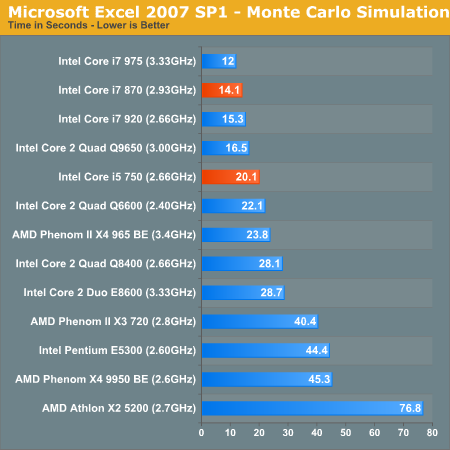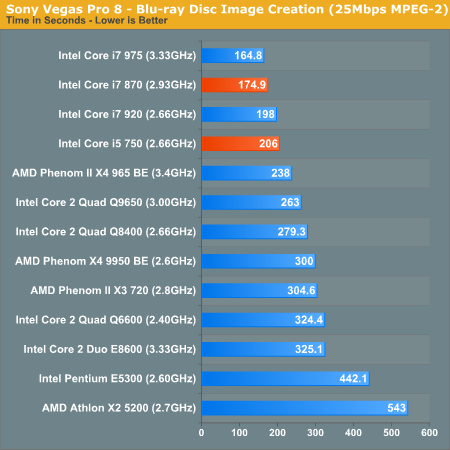Intel's Core i7 870 & i5 750, Lynnfield: Harder, Better, Faster Stronger
by Anand Lal Shimpi on September 8, 2009 12:00 AM EST- Posted in
- CPUs
Microsoft Excel 2007
Excel can be a very powerful mathematical tool. In this benchmark we're running a Monte Carlo simulation on a very large spreadsheet of stock pricing data.

The Excel test is peculiar in its results. It must be one of the few situations where Bloomfield's memory bandwidth advantage is seen as even the Core i7 870 can't outperform the i7 920. The Core 2 Quad Q9650 does well thanks to its large 12MB L2 cache, as does the Q6600 with a beefy 8MB cache.
Sony Vegas Pro 8: Blu-ray Disc Creation
Although technically a test simulating the creation of a Blu-ray disc, the majority of the time in our Sony Vegas Pro benchmark is spend encoding the 25Mbps MPEG-2 video stream and not actually creating the Blu-ray disc itself.

Hyper Threading is good for about 4% here, giving the 920 the slight edge over the Core i5 750.
Sorenson Squeeze: FLV Creation
Another video related benchmark, we're using Sorenson Squeeze to convert regular videos into Flash videos for use on websites.

The i5 750 pays the HT penalty, taking another 20 seconds to render our test video than the i7 920. It is still faster than the Phenom II X4 965 BE at a much lower cost. The Core i7 870 comes close but can't beat the i7 975.










343 Comments
View All Comments
snakeoil - Tuesday, September 8, 2009 - link
what part of stock speed you don't understand?if you are going to compare 2 processors both must have a fixed stock speed, if you increase the frequency of one of them by 1Ghz over the stock speed that is illegal.
or either both have a stock fixed speed to benchmark or both are overclocked.
overclocking is the same it doesn't matter if it's auto overclocking or manual overclocking.
we the people demand justice.
we the people are not stupid.
Anand Lal Shimpi - Wednesday, September 9, 2009 - link
You may find that your desire for fixed speed comparisons will become difficult in the future. Both AMD and Intel are going to be embracing this sort of an approach to clock speeds.Overclocking is not the same as what is happening with turbo mode. Overclocking is not officially supported by the manufacturer, it is running a part faster than it was sold at in order to improve performance. If an application crashes because you've overclocked your chip too far that's no fault of the manufacturer.
Turbo mode runs the chip at a frequency it's guaranteed to work at, it's operating within spec. It simply re-allocates thermal resources; Intel could disable 3 of the cores and sell a Core i7 870 as a 3.6GHz single-core processor, or disable 2 of the cores and sell it as a 3.47GHz processor, or only disable one core and sell it as a 3.2GHz processor. Instead of making the end user choose, instead you get a dynamic processor that can configure itself in real time depending on the workload.
This is in stark contrast to AMD's Overdrive utility which is actually overclocking. The chips aren't validated at the overdrive speeds and you're thus overclocking. Lynnfield is validated at both its standard clock speed and its turbo speeds, just like Bloomfield. So long as you don't exceed the TDP of the chip, it will work at those turbo frequencies. The things that will prevent it from turboing were outlined in the article.
Once again, I am not increasing the speed of anything - Lynnfield is simply working as designed. Whether it's in a Dell machine or in a custom build, it will always work this way. It's what the end user will see the moment they turn on a Lynnfield machine. The end user would not see the same from a Core 2 or a Phenom II based machine.
Take care,
Anand
Jamahl - Wednesday, September 9, 2009 - link
The problem with this review is it has a bunch of graphs with intel cpus with speeds rated at a lot lower than what they actually are.When you show a graph of an i5 @ 2.66 gigahertz beating a 3.4 gigahertz phenom II, that is false and that is a problem. This cpu was not ever at 2.66 gigahertz for any of these tests was it?
I suggest there is a problem with your reviewer also, not to mention his attitude about 'having a laugh' because i brought up this point?
Anand Lal Shimpi - Wednesday, September 9, 2009 - link
Again, that is the default clock of the processor - in many cases (especially the heavily threaded tests) it will be running at that speed. Turbo mode is dynamic, it's impossible to put down exactly what speed the chip was running at as it'll change throughout each test.You might see the chip run at 2.66GHz for several seconds, jump up to 3.46GHz then down to 3.2GHz, up to 3.6GHz and then back down to 2.66GHz all in the course of a single benchmark. It's repeatable, but there's no way to display all of that in a bar chart.
Take care,
Anand
snakeoil - Wednesday, September 9, 2009 - link
What you are doing is cheating, and people is not stupid.you are saying that lynnfield is faster than phenom 2 because lynnfield is overclocked at least 600 mhz.
people is not stupid as you think, and what you are doing is outrageous.
if you are going to benchamark with turbo enabled then you have to overclock phenom 2 at least the same 600 mhz.
show some respect for your readers. or are you really on intel's payroll?
Klober - Wednesday, September 9, 2009 - link
I am usually very respectful on the AnandTech and DailyTech forums and comments areas, but you sir are exactly as stupid as you are claiming people "is" not. Please read the article from beginning to end before continuing on your unjustified tirade. The processor is being used as intended by the manufacturer - to not test it in this way would be a disservice to the engineers who designed it and the company that produces it.snakeoil - Wednesday, September 9, 2009 - link
if you dont want to disable turbo the overclock phenom 2 at least 600 mhz.just to be fair.
Gary Key - Wednesday, September 9, 2009 - link
"if you dont want to disable turbo the overclock phenom 2 at least 600 mhz.just to be fair. "
You do realize that it takes near zero or sub-zero cooling to run the 965BE in stable manner at 4GHz with a 64-bit OS. When I say stable, I mean 24/7 multi-tasking, not a CPUZ screenshot or a SuperPi 1M bench. AMD has not solved this problem with the current stepping.
Once again, and for the last time, Intel's turbo function is a standard feature of the processor. AMD will be offering the exact same technology in their next processor family.
snakeoil - Wednesday, September 9, 2009 - link
that's not true.we demand justice and fair benchmarks.
you are losing all credibility and these benchmarks are worthless and unreal.
goinginstyle - Wednesday, September 9, 2009 - link
How many times do they have to respond to you in a logical manner. You should be banned and in some countries that would mean a beheading for being so damn stupid.